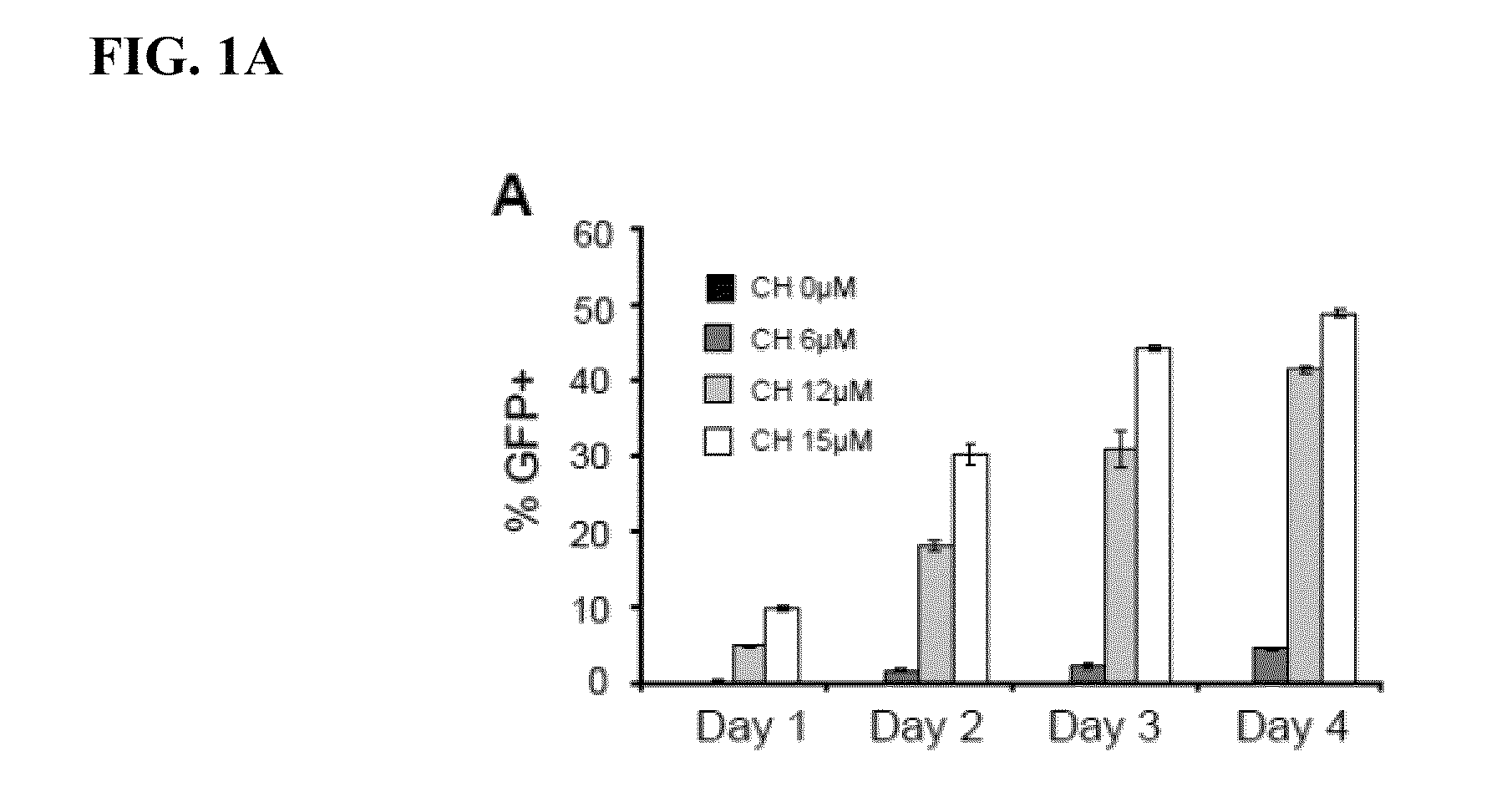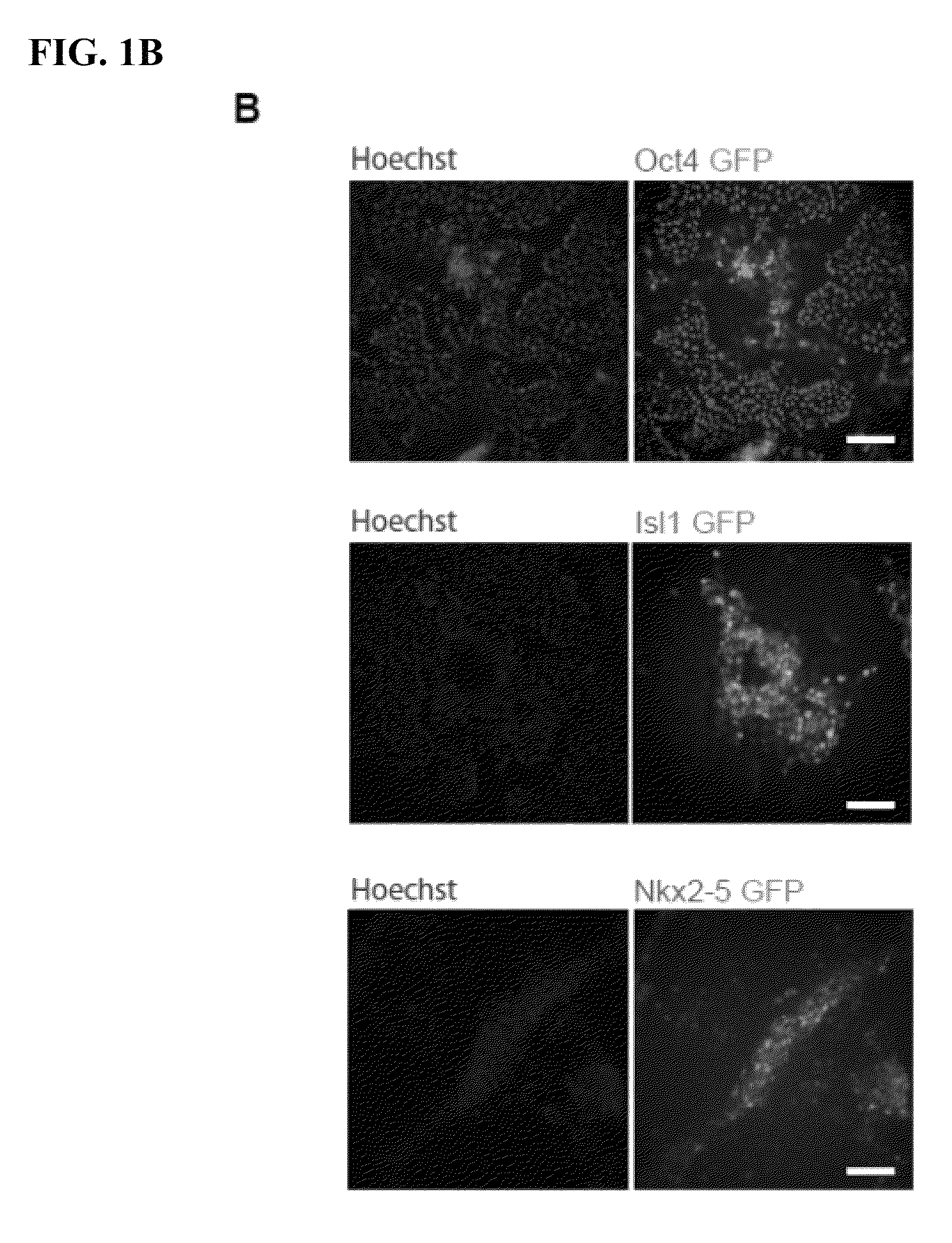Generation of cardiomyocytes from human pluripotent stem cells
a technology of human pluripotent stem cells and cardiomyocytes, which is applied in the field of human pluripotent stem cell generation of cardiomyocytes, can solve the problems of limited usefulness of this approach, labor-intensive protocol, and inapplicability to all pluripotent cell lines
- Summary
- Abstract
- Description
- Claims
- Application Information
AI Technical Summary
Benefits of technology
Problems solved by technology
Method used
Image
Examples
example 1
Experimental Procedures
[0086]Maintenance of hPS Cells:
[0087]Transgene free human iPSCs (6-9-9 and 19-9-11) (Yu et al., Science 324, 797-801 (2009)), lentiviral integrated human iPSC (IMR90C4) (Yu et al., Science 318, 1917-1920 (2007)) and hESCs (H1, H7, H9) (Thomson et al., Science 282, 1145-1147 (1998)) were maintained on MEF feeders in hESC medium: DMEM / F12 culture medium supplemented with 20% KnockOut serum replacer, 0.1 mM non-essential amino acids, 1 mM L-glutamine (all from Invitrogen), 0.1 mM β-mercaptoethanol (Sigma) and 10 ng / ml human bFGF (Invitrogen). For feeder free culture, hPS cells were maintained on Matrigel (BD Biosciences) or Synthemax plates (Corning) in mTeSR1 medium.
[0088]Cardiac Differentiation Via EBs:
[0089]hPS cells were passaged onto MEFs (˜13,000 cells / cm2) and cultured in hESC medium for 2 days followed by another 3 days in hESC medium supplemented with BIO (Sigma) or CHIR99021 (Selleck). To form EBs, hPS cell aggregates generated by dispase treatment were...
example 2
Wnt / β-Catenin Pathway Activation by Gsk3 Inhibitors Abrogates hPS Cell Self-Renewal and Enhances Cardiac Differentiation
[0112]In order to probe the activation of canonical Wnt / β-catenin signaling during hPS cell specification to cardiomyocytes, the inventors generated a series of promoter-reporter cell lines in H1 and H9 hESC, and 19-9-11 human iPSC lines. These reporter lines, integrated with a lentiviral 7TGP vector, express GFP under control of a consensus TCF / LEF binding sequence promoter which reports β-catenin activation (FIG. 2A) (Fuerer and Nusse, PLoS One 5:e9370 (2010)). Whereas Wnt / β-catenin activation has been reported in undifferentiated mESCs and hESCs (Anton et al., FEBS Lett. 581:5247-5254 (2007); Sato et al., Nat. Med. 10:55-63 (2004); Takao et al., Biochem. Bioph. Res. Co. 353:699-705 (2007)), the inventors and others (Dravid et al., Stem Cells 23: 1489-1501 (2005)) failed to observe significant TCF / LEF-mediated transcriptional activity in self-renewing H9 hESCs in...
example 3
Differentiation Induced by Gsk3 Inhibitor Treatment is β-Catenin Dependent
[0114]In order to more fully evaluate the role of canonical Wnt signaling in cardiomyocyte specification of hPS cells, the inventors generated H7, H9 and 19-9-11 iPSC clones carrying lentiviral integrated β-catenin shRNA and control scrambled sequences (FIG. 3A). Referring to FIG. 2A, PU6 and PhPGK are human U6 and human PGK promoters, red and green sequences are forward and reverse shRNA sequence of β-catenin, and the blue sequence represents the loop sequence. The β-catenin knockdown efficiency of the shRNA knockdown lines compared to the scrambled lines was 77% for β-catenin shRNA sequence 1 (shcat-1) and 96% for sequence 2 (shcat-2) (FIGS. 3B, 4A and 4B). Knockdown of β-catenin did not abrogate hESC or iPSC self-renewal, as shown by Oct4 expression (FIGS. 4C and 4D).
[0115]To test whether induction of cardiornyocyte differentiation by GSK3 inhibitors requires β-catenin, the inventors treated the shcat-2 and...
PUM
| Property | Measurement | Unit |
|---|---|---|
| concentrations | aaaaa | aaaaa |
| time | aaaaa | aaaaa |
| time | aaaaa | aaaaa |
Abstract
Description
Claims
Application Information
 Login to View More
Login to View More - R&D
- Intellectual Property
- Life Sciences
- Materials
- Tech Scout
- Unparalleled Data Quality
- Higher Quality Content
- 60% Fewer Hallucinations
Browse by: Latest US Patents, China's latest patents, Technical Efficacy Thesaurus, Application Domain, Technology Topic, Popular Technical Reports.
© 2025 PatSnap. All rights reserved.Legal|Privacy policy|Modern Slavery Act Transparency Statement|Sitemap|About US| Contact US: help@patsnap.com



